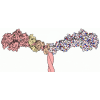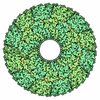[English] 日本語
 Yorodumi
Yorodumi- PDB-6g2t: human cardiac myosin binding protein C C1 Ig-domain bound to nati... -
+ Open data
Open data
- Basic information
Basic information
| Entry | Database: PDB / ID: 6g2t | ||||||
|---|---|---|---|---|---|---|---|
| Title | human cardiac myosin binding protein C C1 Ig-domain bound to native cardiac thin filament | ||||||
 Components Components |
| ||||||
 Keywords Keywords | CONTRACTILE PROTEIN / Cardiac thin filament regulator | ||||||
| Function / homology |  Function and homology information Function and homology informationbasal body patch / C zone / regulation of muscle filament sliding / striated muscle myosin thick filament / tight junction assembly / A band / regulation of striated muscle contraction / cardiac myofibril / profilin binding / protein localization to bicellular tight junction ...basal body patch / C zone / regulation of muscle filament sliding / striated muscle myosin thick filament / tight junction assembly / A band / regulation of striated muscle contraction / cardiac myofibril / profilin binding / protein localization to bicellular tight junction / regulation of transepithelial transport / Formation of annular gap junctions / morphogenesis of a polarized epithelium / Formation of the dystrophin-glycoprotein complex (DGC) / structural constituent of postsynaptic actin cytoskeleton / Gap junction degradation / Cell-extracellular matrix interactions / dense body / regulation of stress fiber assembly / Striated Muscle Contraction / Adherens junctions interactions / M band / regulation of cardiac muscle cell contraction / Sensory processing of sound by outer hair cells of the cochlea / Interaction between L1 and Ankyrins / structural constituent of muscle / sarcomere organization / Sensory processing of sound by inner hair cells of the cochlea / regulation of focal adhesion assembly / apical junction complex / positive regulation of wound healing / myosin heavy chain binding / ventricular cardiac muscle tissue morphogenesis / myosin binding / maintenance of blood-brain barrier / NuA4 histone acetyltransferase complex / filamentous actin / myofibril / Recycling pathway of L1 / ATPase activator activity / EPH-ephrin mediated repulsion of cells / RHO GTPases Activate WASPs and WAVEs / regulation of synaptic vesicle endocytosis / RHO GTPases activate IQGAPs / RHOBTB2 GTPase cycle / heart morphogenesis / cardiac muscle contraction / phagocytic vesicle / titin binding / EPHB-mediated forward signaling / axonogenesis / calyx of Held / sarcomere / Translocation of SLC2A4 (GLUT4) to the plasma membrane / FCGR3A-mediated phagocytosis / actin filament / cell motility / RHO GTPases Activate Formins / Signaling by high-kinase activity BRAF mutants / MAP2K and MAPK activation / Regulation of actin dynamics for phagocytic cup formation / cellular response to type II interferon / structural constituent of cytoskeleton / Hydrolases; Acting on acid anhydrides; Acting on acid anhydrides to facilitate cellular and subcellular movement / platelet aggregation / VEGFA-VEGFR2 Pathway / Schaffer collateral - CA1 synapse / Signaling by RAF1 mutants / Signaling by moderate kinase activity BRAF mutants / Paradoxical activation of RAF signaling by kinase inactive BRAF / Signaling downstream of RAS mutants / cell-cell junction / Signaling by BRAF and RAF1 fusions / actin cytoskeleton / Clathrin-mediated endocytosis / actin binding / angiogenesis / blood microparticle / cytoskeleton / hydrolase activity / cell adhesion / positive regulation of cell migration / axon / focal adhesion / synapse / ubiquitin protein ligase binding / positive regulation of gene expression / protein kinase binding / extracellular space / extracellular exosome / ATP binding / metal ion binding / identical protein binding / nucleus / membrane / plasma membrane / cytosol / cytoplasm Similarity search - Function | ||||||
| Biological species |  Homo sapiens (human) Homo sapiens (human) | ||||||
| Method | ELECTRON MICROSCOPY / helical reconstruction / cryo EM / Resolution: 9 Å | ||||||
 Authors Authors | Risi, C. / Belknap, B. / Forgacs, E. / Harris, S.P. / Schroder, G.F. / White, H.D. / Galkin, V.E. | ||||||
| Funding support |  United States, 1items United States, 1items
| ||||||
 Citation Citation |  Journal: Structure / Year: 2018 Journal: Structure / Year: 2018Title: N-Terminal Domains of Cardiac Myosin Binding Protein C Cooperatively Activate the Thin Filament. Authors: Cristina Risi / Betty Belknap / Eva Forgacs-Lonart / Samantha P Harris / Gunnar F Schröder / Howard D White / Vitold E Galkin /   Abstract: Muscle contraction relies on interaction between myosin-based thick filaments and actin-based thin filaments. Myosin binding protein C (MyBP-C) is a key regulator of actomyosin interactions. Recent ...Muscle contraction relies on interaction between myosin-based thick filaments and actin-based thin filaments. Myosin binding protein C (MyBP-C) is a key regulator of actomyosin interactions. Recent studies established that the N'-terminal domains (NTDs) of MyBP-C can either activate or inhibit thin filaments, but the mechanism of their collective action is poorly understood. Cardiac MyBP-C (cMyBP-C) harbors an extra NTD, which is absent in skeletal isoforms of MyBP-C, and its role in regulation of cardiac contraction is unknown. Here we show that the first two domains of human cMyPB-C (i.e., C0 and C1) cooperate to activate the thin filament. We demonstrate that C1 interacts with tropomyosin via a positively charged loop and that this interaction, stabilized by the C0 domain, is required for thin filament activation by cMyBP-C. Our data reveal a mechanism by which cMyBP-C can modulate cardiac contraction and demonstrate a function of the C0 domain. | ||||||
| History |
|
- Structure visualization
Structure visualization
| Movie |
 Movie viewer Movie viewer |
|---|---|
| Structure viewer | Molecule:  Molmil Molmil Jmol/JSmol Jmol/JSmol |
- Downloads & links
Downloads & links
- Download
Download
| PDBx/mmCIF format |  6g2t.cif.gz 6g2t.cif.gz | 524.7 KB | Display |  PDBx/mmCIF format PDBx/mmCIF format |
|---|---|---|---|---|
| PDB format |  pdb6g2t.ent.gz pdb6g2t.ent.gz | 421.7 KB | Display |  PDB format PDB format |
| PDBx/mmJSON format |  6g2t.json.gz 6g2t.json.gz | Tree view |  PDBx/mmJSON format PDBx/mmJSON format | |
| Others |  Other downloads Other downloads |
-Validation report
| Summary document |  6g2t_validation.pdf.gz 6g2t_validation.pdf.gz | 816.3 KB | Display |  wwPDB validaton report wwPDB validaton report |
|---|---|---|---|---|
| Full document |  6g2t_full_validation.pdf.gz 6g2t_full_validation.pdf.gz | 869.8 KB | Display | |
| Data in XML |  6g2t_validation.xml.gz 6g2t_validation.xml.gz | 78.7 KB | Display | |
| Data in CIF |  6g2t_validation.cif.gz 6g2t_validation.cif.gz | 125.6 KB | Display | |
| Arichive directory |  https://data.pdbj.org/pub/pdb/validation_reports/g2/6g2t https://data.pdbj.org/pub/pdb/validation_reports/g2/6g2t ftp://data.pdbj.org/pub/pdb/validation_reports/g2/6g2t ftp://data.pdbj.org/pub/pdb/validation_reports/g2/6g2t | HTTPS FTP |
-Related structure data
| Related structure data |  4346MC  7780C  7781C  6cxiC  6cxjC M: map data used to model this data C: citing same article ( |
|---|---|
| Similar structure data |
- Links
Links
- Assembly
Assembly
| Deposited unit | 
|
|---|---|
| 1 |
|
- Components
Components
| #1: Protein | Mass: 41838.766 Da / Num. of mol.: 6 Source method: isolated from a genetically manipulated source Source: (gene. exp.)  Homo sapiens (human) / Gene: ACTG1, ACTG / Production host: Homo sapiens (human) / Gene: ACTG1, ACTG / Production host:  Homo sapiens (human) / References: UniProt: P63261 Homo sapiens (human) / References: UniProt: P63261#2: Protein | Mass: 12180.806 Da / Num. of mol.: 6 Source method: isolated from a genetically manipulated source Source: (gene. exp.)  Homo sapiens (human) / Gene: MYBPC3 / Production host: Homo sapiens (human) / Gene: MYBPC3 / Production host:  #3: Protein | Mass: 11507.176 Da / Num. of mol.: 4 / Source method: isolated from a natural source / Source: (natural)  |
|---|
-Experimental details
-Experiment
| Experiment | Method: ELECTRON MICROSCOPY |
|---|---|
| EM experiment | Aggregation state: HELICAL ARRAY / 3D reconstruction method: helical reconstruction |
- Sample preparation
Sample preparation
| Component |
| |||||||||||||||||||||||||||||||||||
|---|---|---|---|---|---|---|---|---|---|---|---|---|---|---|---|---|---|---|---|---|---|---|---|---|---|---|---|---|---|---|---|---|---|---|---|---|
| Molecular weight | Experimental value: NO | |||||||||||||||||||||||||||||||||||
| Source (natural) |
| |||||||||||||||||||||||||||||||||||
| Source (recombinant) |
| |||||||||||||||||||||||||||||||||||
| Buffer solution | pH: 7 | |||||||||||||||||||||||||||||||||||
| Specimen | Embedding applied: NO / Shadowing applied: NO / Staining applied: NO / Vitrification applied: YES | |||||||||||||||||||||||||||||||||||
| Specimen support | Grid material: COPPER / Grid mesh size: 300 divisions/in. | |||||||||||||||||||||||||||||||||||
| Vitrification | Instrument: FEI VITROBOT MARK II / Cryogen name: ETHANE / Humidity: 95 % / Chamber temperature: 294 K |
- Electron microscopy imaging
Electron microscopy imaging
| Experimental equipment |  Model: Titan Krios / Image courtesy: FEI Company |
|---|---|
| Microscopy | Model: FEI TITAN KRIOS |
| Electron gun | Electron source:  FIELD EMISSION GUN / Accelerating voltage: 300 kV / Illumination mode: FLOOD BEAM FIELD EMISSION GUN / Accelerating voltage: 300 kV / Illumination mode: FLOOD BEAM |
| Electron lens | Mode: BRIGHT FIELD |
| Image recording | Electron dose: 20 e/Å2 / Detector mode: INTEGRATING / Film or detector model: FEI FALCON II (4k x 4k) |
- Processing
Processing
| EM software |
| ||||||||||||||||||||||||||||||||||||
|---|---|---|---|---|---|---|---|---|---|---|---|---|---|---|---|---|---|---|---|---|---|---|---|---|---|---|---|---|---|---|---|---|---|---|---|---|---|
| CTF correction | Type: PHASE FLIPPING AND AMPLITUDE CORRECTION | ||||||||||||||||||||||||||||||||||||
| Helical symmerty | Angular rotation/subunit: -166.6 ° / Axial rise/subunit: 27.7 Å / Axial symmetry: C1 | ||||||||||||||||||||||||||||||||||||
| 3D reconstruction | Resolution: 9 Å / Resolution method: FSC 0.143 CUT-OFF / Num. of particles: 7051 / Symmetry type: HELICAL | ||||||||||||||||||||||||||||||||||||
| Atomic model building | Protocol: FLEXIBLE FIT / Space: REAL / Target criteria: Cross-correlation coefficient |
 Movie
Movie Controller
Controller










 PDBj
PDBj




















